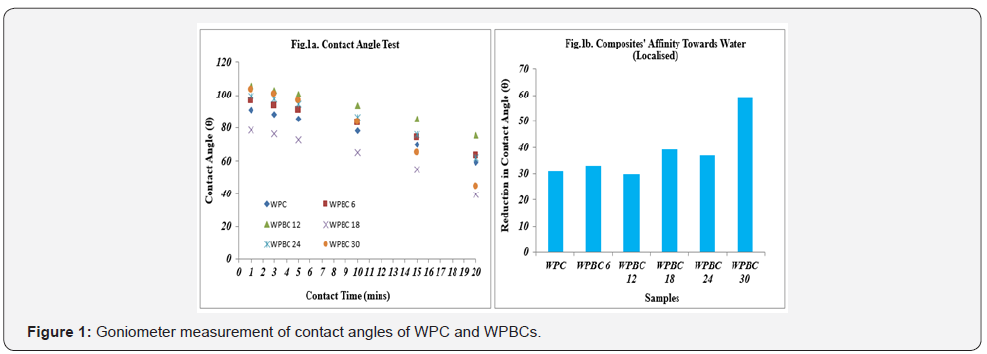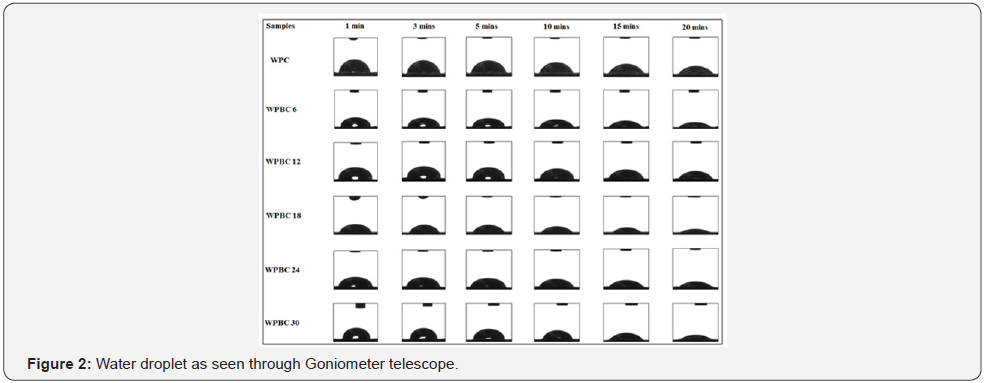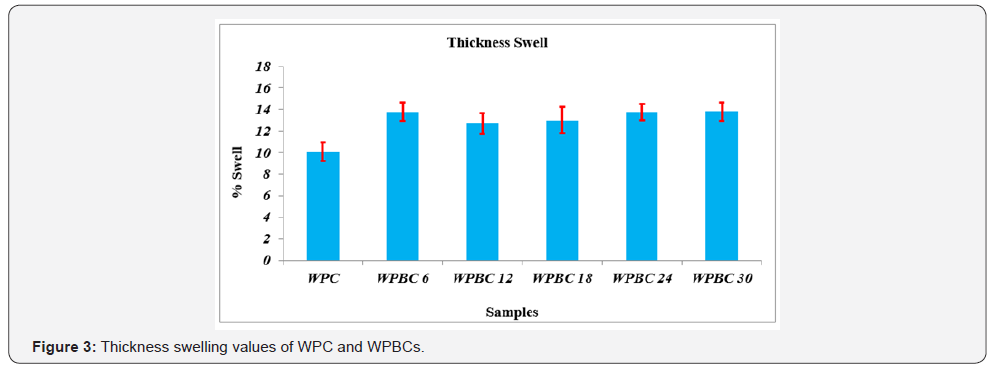Wettability Properties of Biochar Added Wood/Polypropylene Composites-Juniper Publishers
JUNIPER
PUBLISHERS- Academic Journal of Polymer Science
Abstract
In an attempt to comprehend the outdoor application
potential of biochar reinforced wood and polypropylene composites, their
wettability properties were investigated. The localised water affinity
was measured through drop shape analysis in a Goniometer whereas the
comprehensive susceptibility towards water was done through a thickness
swell test. The results indicate that the addition of 12wt% of wood
waste (Pinus radiata) biochar to a wood and polypropylene composite had
the highest resistance towards water among the three component
composites. In general, the predilection towards water increased with an
increase in the amount of biochar in the composites. It is recommended
to produce the biochar with low pyrolysis temperature (yielding a more
hydrophobic biochar) to develop composites with acceptable water
opposing properties.
Keywords: Wood; Polypropylene; Biocomposites; Biochar; Wettability; GoniometerIntroduction
Increased environmental awareness and diminishing
natural resources have together provided the impetus to explore and use
materials that are waste based. These motivations coupled with
regulation-based impetus enforced by government and regional councils
have led to the research and development of innovative waste-derived
products [1,2]. Biochar is a renewable material which can be produced by
valorising any organic biomass (e.g. forestry, crop residue, poultry
waste, dairy manure) in an oxygen free environment by a pyrolysis
process [3]. Until now, the application of biochar was limited to soil
amendment, filtration and contaminant/heavy metal removal [4]. In order
to make its application diverse, the biochar derived from organic wastes
was incorporated with conventional wood and polymer composites to yield
wood polymer biochar composites (WPBC) [5-7]. Through these works, the
authors have demonstrated that biochar could be applied as reinforcement
in wood polymer composites to improve their mechanical, thermal and
fire properties as well as to reduce the use of costly coupling agents.
The development of wood polymer and biochar composites requires the
knowledge of its physico-mechanical properties. The mechanical, chemical
and thermal properties of the WPBC were evaluated by Das et al. [5]
However, prior to the application of this composite, it is critical to
comprehend the endurance of WPBC towards external environment.
Similarly, to other wood polymer composites (WPCs), WPBC can be applied
in making decking material, windows and door panels and automotive
parts [8]. These types of applications may expose the WPBC to rainfall
and humid conditions, hence, the wettability properties of WPBC should
be investigated.
WPBC consists of three distinct constituents
(biochar, wood and polymer) that differ in their interactions with
water. The physical and chemical properties of the different
constituents of WPBC may stay distinct macroscopically in the final
product while exhibiting synergistic material properties [9]. As a
result, individual components would have an additive effect on the final
physico-chemical nature of the composites. This would consequently
affect the overall wettability properties of WPBC.
The main objective of the study was to investigate
the resistance of WPBC towards water in general and specifically how
different loading amounts of biochar in the composite affected the
resulting wettability.
Materials and Methods
The detail description of the process and methods
used to develop biochar added wood and polymer composites can be found
in Das et al. [5]. Briefly, the constituents were dry blended, then melt
blended in an extruder and finally compression moulded to manufacture
the samples. Six different samples were manufactured containing 0, 6,
12, 18, 24, and 30 wt% biochar, which was produced by pyrolysis of waste
pine wood. The samples were named WPC (control, 0 wt% biochar
reinforcement), WPBC 6; WPBC 12; WPBC 18; WPBC
24 and WPBC 30, based on the weight percentage of biochar in
them. After manufacturing of the WPC and WPBCs, wettability
properties were investigated.
Localised wettability was measured in a Goniometer (KSV
instruments, Finland, Model: CAM101, software: Attension
Theta) through drop shape analysis. The contact angles of
deionised (D.I.) water (volume= 4μl) was measured (mean
of right and left contact angles) on a flat sample surface at an
interval of 60 s for a period of 20min. Swelling tests were carried
out according to ASTM D-7031-04 protocol. Three specimens of
each formulation were selected at random and bone dried in a
convection oven for 24h at 105 °C. This was followed by cooling
the samples to room temperature in a desiccator. The specimens
were then immersed in D.I. water for 24h at room temperature.
The excess water on the surface was wiped off by tissue paper.
The values of the thickness swelling in percentages were
calculated using the following equation:

where,
TS= Thickness swell in percentage
T(f)= Final thickness
T(i)= Initial thickness
Results and Discussion
Figure 1 shows the localised water absorption of the WPC
and WPBCs measured with a Goniometer. Figure 1a shows the
changes in contact angles of water on the composite’s surface
with respect to time, whereas, Figure 1b shows the difference
in initial and final contact angles for each sample. The initial
contact angle at 1min was not indicative of the samples’ affinity
(i.e. degree of absorption) towards water. The noteworthy
observation is how the contact angle changed i.e. became
smaller with respect to time. It can be observed from Figure 1a
that all the composites follow a similar pattern when wettability
towards water is concerned: with time, the contact angle
decreased representing the movement of water into the surface
of the composite and evaporation.
The composites’ affinity towards water can be understood
by the change in the initial and the final contact angle of water
droplet. The higher the difference is between the final and the
initial value of contact angle, the higher is the affinity towards
water. It is clear from the Figure 1b that the composites having
higher amount of biochar (WPBC 18, 24 and 30) had a higher
affinity towards water. This is attributed to the lower amount
of the hydrophobic polymer (i.e. polypropylene) in the blends.
WPBC 30 had the highest affinity towards water, as the
polypropylene content was the lowest among all blends. Though
biochar can be hydrophobic provided they are made at lower
pyrolysis temperature (<400 °C) [10], the one used in this study
was made at 450 °C. As the pyrolysis temperature is raised, the
volatiles escape creating pores on biochar surface. Water can be
absorbed into these pores through capillary action. Hence, the
higher temperature biochar’s inherent affinity towards water
and the lower content of the hydrophobic polypropylene made
the composites with higher amount of biochar more susceptible
to water. Additionally, the increase in the amount of biochar
also increased the proportion of wood in each blend [5,11]. The
prominence of the wood component further made the composite
samples containing higher amounts of biochar more susceptible
to wetting. This is because the wood is naturally hygroscopic due
to formation of hydrogen bonds between wood biopolymers and
the water molecules [12].

Figure 2 shows the shape of the water droplet, as seen
through the goniometer telescope, on the flat surfaces of each
samples at intervals of 1, 3, 5, 10, 15, and 20min. WPC (control)
was most resistant to water compared to all the composites
containing biochar. Similar to the observation made from
Figure 1a and 1b, the contact angles drastically decreased in the
WPBC samples containing more biochar (WPBC 6, 18, 24, and
30). An exception was WPBC 12, where the amounts of wood,
biochar and polymer were optimal to provide it with maximum
resistance towards water. WPBC 12 and WPC had an almost
similar resistance towards localised water absorption. This
observation corroborates the results of Figure 1b.

Figure 3 shows the percentage thickness swell of the
samples after immersion in water for 24h. It can be seen that,
in general, there was a gradual increase in the thickness swell
as the amount of biochar increased in the samples of WPBC (not
considering WPBC 6). This trend is attributed to the increased
amount of less hydrophobic biochar, decreased amount of
hydrophobic polypropylene and increased contribution of
hydrophilic wood [5]. The thickness swell value for WPBC 6
was the highest among all WPBCs and this was probably due to
the presence of voids formed during its manufacturing [5]. The
voids acted as pockets for the increased collection of water and
consequently increased in size leading to WPBC 6’s overall high
thickness swell. Theoretically, WPBC 30 should have had the
highest swelling value but from Figure 3 it can be observed that
both WPBC 6 and 30 have identical swelling values (13.8 and
13.8%, respectively). Hence, it becomes clear that the presence
voids from manufacturing are detrimental for the wettability
properties of composites having biochar additive. On the other
hand, the composite WPBC 12 had the lowest swelling value
(12.7%) among all WPBCs, which is in agreement with the
observation made in Figure 1 & 2.

The swelling of any WPBCs was higher than the control
(WPC). This is not favourable when application of WPBC in
field conditions is considered. However, to make a composite
resistant to the swelling, it is recommended to use biochars
that are made at lower pyrolysis temperatures (<400 °C).
Biochars made at lower temperatures have pores that are
clogged by the tar, which is unable to escape during pyrolysis.
Due to the presence of tar, these biochars exhibit hydrophobic aliphatic groups on their surface [13]. This clogging
also makes the number of pores and the surface area smaller.
Hence, the collective effect of hydrophobic tar on the surface
and pore clogging lowers the affinity of the biochar towards
water [14]. On the other hand, biochar made at lower pyrolysis
temperatures tend to have a lower content of elemental carbon
and lower hardness [4,15], which consequently reduces the
quality and reinforcement ability of this biochar. In order to make
a high-quality biocomposite, an optimal production temperature
of biochar should be chosen to obtain a hydrophobic biochar
containing a high amount of elemental carbon and having an
increased hardness.
Conclusion
From the investigation conducted on the wettability
properties of wood and polypropylene composites having a
biochar additive, the following conclusions can be drawn:
i. The addition of 12wt% of biochar in a wood and
polymer composite bestows it the highest resistance towards
water.
ii. The increase of biochar content in the composite makes
it more susceptible to water
iii. High production temperature of biochar increases its
affinity towards water (absorption through capillary action
of pores); hence such biochar type is not recommended for
reinforcing composites aimed for the robust hydrophobicity.
For more articles in Academic Journal of Polymer
Science please click on:
https://juniperpublishers.com/ajop/index.php
https://juniperpublishers.com/ajop/index.php

Comments
Post a Comment